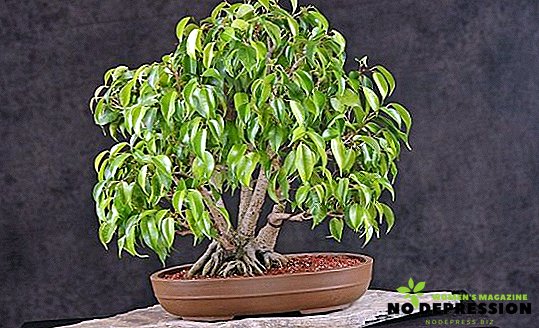In recent years, the interior of modern offices and apartments began to decorate earlier is not at all a popular plant - Benjamin's ficus. The secret of his popularity is simple - Benjamin Ficus does not need constant and careful care, but he is always ready to please his owner with a lush green crown.

Therefore, Benjamin Ficus received such fame among office workers and people who want to plant trees in a private house or apartment, but suffer from a lack of time to care for their green pets.
Plant description
Ficus benjamina refers to the evergreen plants. Having a relatively small size, it resembles a tree, has an erect stem, covered with smooth gray or creamy bark, and a crown with many forks. Like most tropical plants, Benjamin Ficus can grow aerial roots from the trunk.
Indoor ficuses are much smaller than their wild-growing counterparts. Benjamin Ficus in a flowerpot will grow by 2-3 meters in height, while its wild form reaches 20-30 meters in adulthood.
Depending on the type of ficus, the leaves of flowers have different colors, but they retain their size and shape. Most often they are oval with a pointed end, 5-12 centimeters in length and from 2 to 6 cm in width.
How to care for Benjamin ficus
 When purchasing a green pet, you should know what conditions will be favorable for this plant. Benjamin Ficus unpretentious, however, and it must be taken care of.
When purchasing a green pet, you should know what conditions will be favorable for this plant. Benjamin Ficus unpretentious, however, and it must be taken care of.
Benjamin Ficus requires a large amount of light, but direct sunlight is well tolerated only varieties with variegated leaves. For plants with dark green leaves need to arrange diffused lighting.
That is why dark-leaved varieties of this flower are advised to be placed in rooms with windows facing west or east, but the northern and southern windows should be left for other indoor plants - there flowers will suffer from a lack or excess of sunlight.
In winter, lack of sunlight becomes the main cause of the poor condition of the plant. To prevent this, it is advised to acquire a special fitolampa, this energy-saving device will provide Ficus with enough light.
Benjamin's ficus is a tropical plant, therefore it is necessary to water it a lot and often, especially in summer, when the plant grows intensively. But in winter and autumn you need to reduce watering, the flower will be enough once a week. The lack of moisture is immediately noticeable - the ficus seems to be offended, its leaves begin to turn yellow and fall off.
Water quality is also important. For proper development of the plant, it is necessary to water it with boiled or distilled water, the temperature should be slightly above room temperature.
Ficus as a representative of the tropical flora needs a high moisture content in the air. In winter, it almost does not affect the well-being of the plant, but in summer it is better to spray it with water once every 2 days.
It is also recommended to sometimes wash the plant under a weak-pressure shower, this will help the plant to develop properly and protect it from parasitic insects.
Soil for these tropical plants should be as close as possible to the one in which they grow in their natural habitat. Therefore, for planting, you must either buy a special soil mixture in advance, or prepare it yourself. To do this, mix deciduous and sod land, add peat and coarse sand. You can also add pieces of charcoal to improve drainage. We must not forget to periodically loosen the soil to increase the flow of oxygen to the roots of the flower.
The best temperature for a flower in summer is 18-23 degrees, in winter it should be at least 16 degrees. Also, plants at any time of the year need fresh air. This can be achieved by exposing plants to the balcony, pre-insulating from drafts - these flowers suffer from them the most.
Ficus Benjamin does not tolerate permutations, so you need to immediately select a permanent place in the room. Otherwise, the plant will begin to shed its leaves, and it will take a long time to recover from the leaves.
However, the reason for the loss of leaves can be not only moving the pot with a flower to a new place, but also drafts, lack or excess of moisture, hypothermia. However, the loss of a small amount of leaves is a common occurrence that accompanies the proper formation of a plant.
Top dressing
Fertilizer in the soil for Benjamin ficus can be from March to late summer. The choice of fertilizer is determined by the composition of the soil. For example, if a plant lives in ordinary soil mixture, it is necessary to apply organic fertilizer twice a month. In the spring, during the period of active growth, it is advised to apply fertilizers containing nitrogen.
In winter, fertilizers do not benefit plants. In the cold season, the flowers are at rest. Fertilizers will weaken the plants, they will not allow it to develop properly: the plant is strongly drawn out, the branches become thinner.
Transfer
The most favorable time for the resettlement of Benjamin Ficus - spring, because at this time the flower only comes out of a state of rest.
To successfully move the plant to another container, you must follow these rules:
- As mentioned above, it is necessary to give the plant time to adapt to the changing environmental conditions. This will help the flower to settle down better in the new substrate.
- For transplantation, use either universal soil mixtures or special mixtures for ficuses. The soil remaining after planting other indoor plants, it is better to use for another flower, it will not work with ficus.
- Ficus should be transplanted into a pot, the diameter of which will be 2-3 centimeters larger than the one in which the ficus used to grow.
- Before filling the tank with primer, drainage is placed on the bottom.
- When replanting this flower, it is important to try not to disturb the earthy clod, which were woven around the small roots of the plant. They are very fragile, and any attempt to cleanse them of excess land hurts them.
- After transplanting for two days, the plant is not watered. Only then can you water it normally.
- Despite the fact that Benjamin's ficus is advised to be fed regularly, it is not necessary to add fertilizers in the first two weeks in a new pot.
- Actively growing flowers are recommended to replant each year, mature plants need to change the pot every two to three years.
If transplantation is not required, but you need to make the soil more fertile, then you can carefully remove a few centimeters of the top layer of soil and replace it with fresh. Carry out this procedure must be very careful not to injure the small roots of the plant.
Breeding
There are two ways of reproduction of these flowers, however all of them differ in efficiency. Ficuses reproduce well by cuttings and almost always successfully take root and take root.
Method 1
The apical stalk of the ficus is simply cut, placed in a container with water and left until the roots appear. Also, the stalk can be rooted immediately in the soil, it is only important to constantly monitor its moisture. The stalk planted in the ground, it is advised to cover with a transparent jar. This will help create a special microclimate and speed up the rooting process.
As soon as the ficus begins to grow, the jar is removed. Moisten the cuttings should be carefully, not allowing an excess of moisture. When young plants get stronger, they are planted in separate pots filled with pre-prepared mixture for ficuses.
Method 2
Among experienced flower growers, the method of propagation by air layer has become very popular. This procedure is as follows: around the circumference of the stem, make a shallow incision and wrap this place with moist moss. On top of the moss they stretch a transparent film or plastic bag, which should be tightly attached to the stem. This prevents evaporation of moisture and drying of the cut. After 1.5-2 months, when the bag with moss is filled with roots, the stem is cut below the cuttings and immediately planted into the ground.
Conclusion
Ficus Benjamin - one of the most popular plants used for landscaping private houses, apartments and offices. At home, both an inexperienced florist and a professional can successfully grow it, many have already appreciated not only the decorativeness of this plant, but also its simplicity. But we must not forget about the features of the flower, planning care for him. Like any green pet, Benjamin's ficus will please with lush foliage only a caring owner, so the main measures for caring for him should be treated very carefully.
The main rule for feeding, transplanting, pruning and planting Benjamin ficus - any manipulations with this flower should be carried out with the onset of spring, taking into account the life cycle of the plant, which begins with an increase in temperature and an increase in the amount of sunlight
The ficus is particularly sensitive to changes in lighting and temperature, so these factors should be given special attention. Mineral and organic fertilizers are no less important for the plant, it is important not to forget to bring them in specific quantities at certain times of the year. Then the ficus will soon delight its owner with a flowering that is able to impress an experienced grower.












